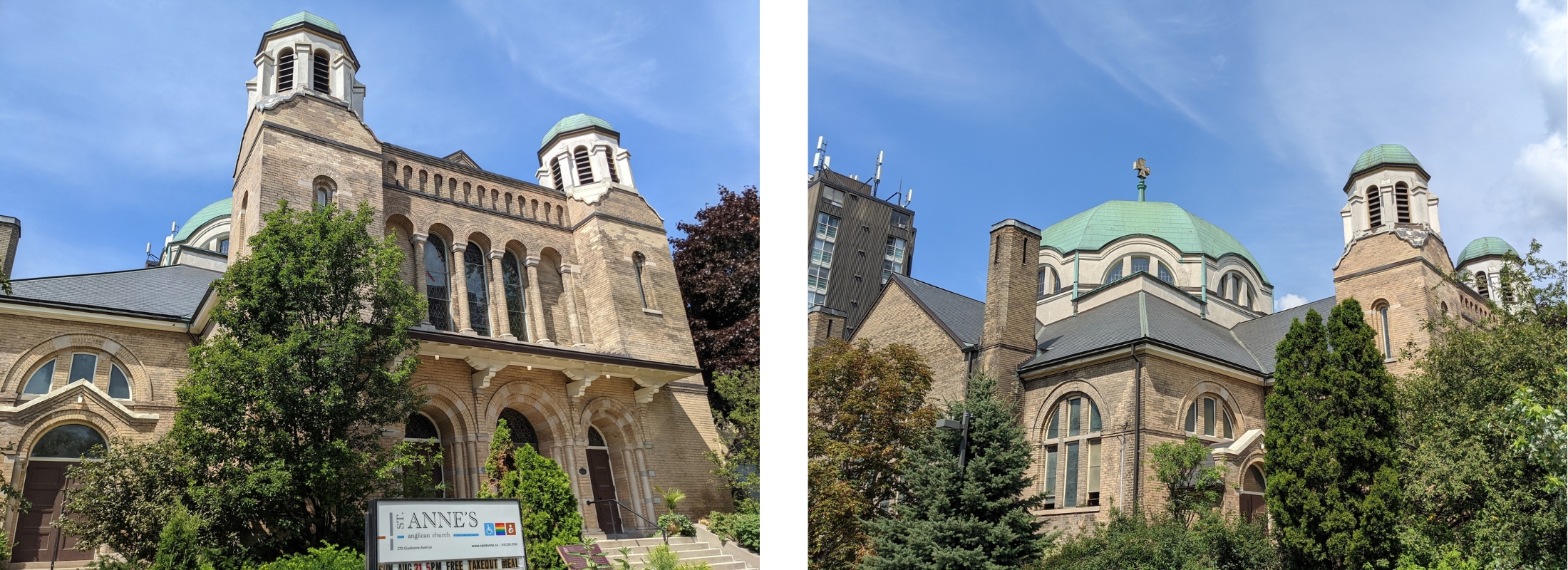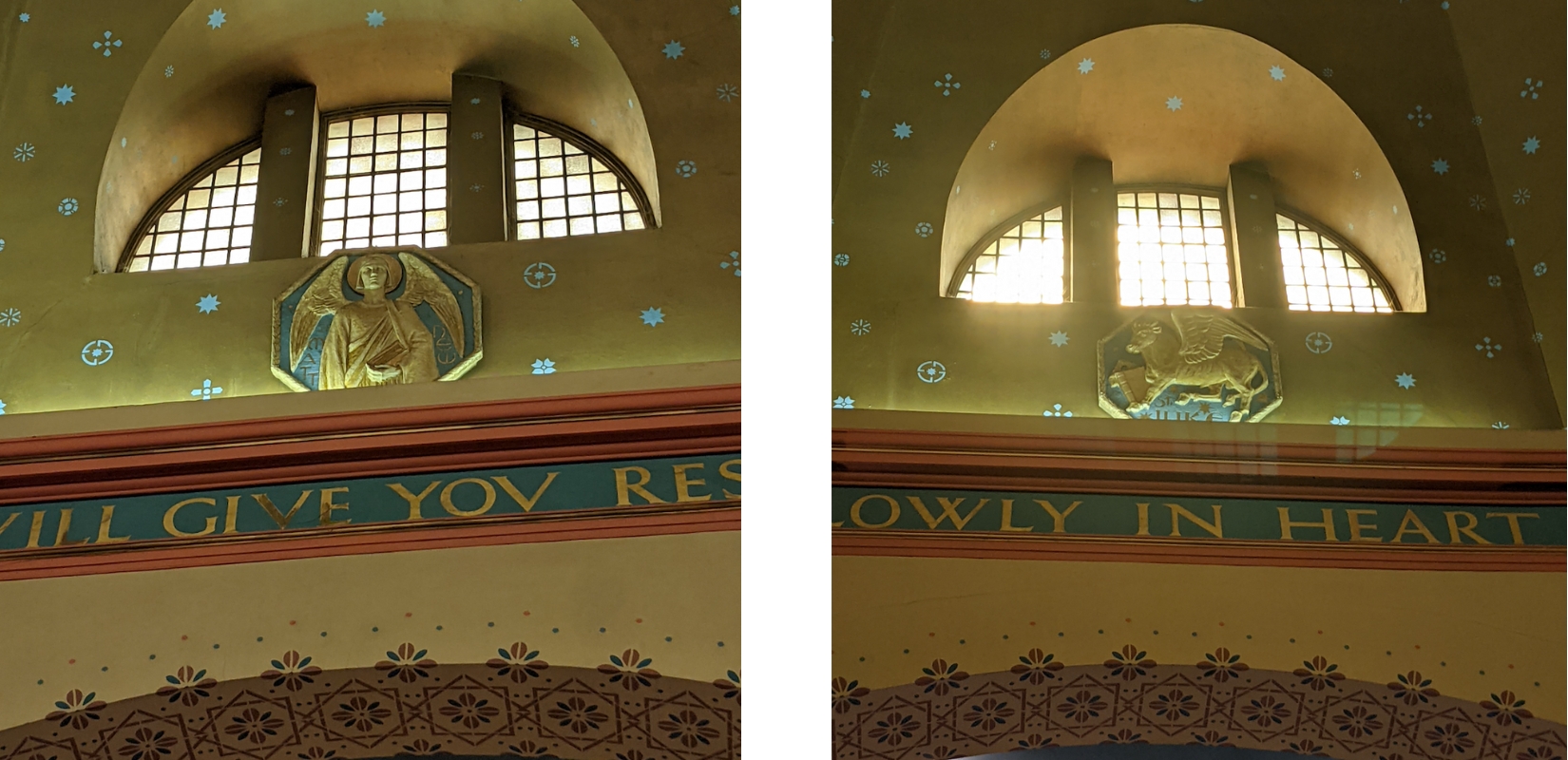On Sunday, June 9, 2024, a fire broke out at St. Anne’s Anglican Church on Gladstone Avenue in Toronto. I could see the smoke from my place that morning, not realizing, or ever thinking it might be a National Historic Site of Canada and one of the city’s greatest heritage treasures that went up in flames. I am heartbroken, as are many across the city and the country—the building was decimated. But what was it that made this building so special?
This Byzantine-inspired church—a sort of mini Hagia Sophia in downtown Toronto, as described at the time of construction—was designed in 1907 by W. Ford Howland (figs. 1-2).

It was notable not just for its unique style of architecture in the Canadian context, but also for the art within. In 1923, James Edward Hervey MacDonald, one of the founding members of the Group of Seven, was hired by the Reverend Lawrence Skey to create the decorative program for the interior. He designed the overall scheme of pictorial and ornamental murals, and enlisted several other artists to help him realize the ambitious project. Namely, he brought on fellow Group of Seven members Fred Varley and Franklin Carmichael. This is why it was often called “The Group of Seven Church.” But other Toronto artists also contributed: these were the painters Neil Mackechnie, Arthur Martin, H.S. Palmer, H.S. Stansfield, and Thoreau MacDonald (J.E.H. MacDonald’s son), as well as the sculptors Frances Loring and Florence Wyle, who designed the reliefs of the Four Evangelists, set in octagonal frames, that were placed at the base of the dome (figs. 3-4).

These sculptures have often been overlooked in the overall fame and heritage recognition of the church. In fact, the outdated Ontario Heritage plaque relegated the unnamed women to the status of “associates” of the Group of Seven members—but the sculptures were an important part of the ensemble. It is clear that Loring and Wyle were invited to contribute as equals, and as artists at the top of their game. This was no small feat as women working as professional artists in the early-twentieth century, but also in a medium not normally associated with “women’s work” at the time. The murals have and will continue to receive the bulk of the attention, but it is important to remember the contributions of Loring and Wyle who have received much less scholarly and public acclaim than the Group of Seven overall.
Not only did the church contain the only known religious works by members of the Group of Seven, but the ensemble was the sole surviving site-specific work by Group members. In fact, it was one of only a handful site-specific works ever created by any member of the Group. Of all Group members, only MacDonald engaged with mural art, having done a series of landscape murals for a friend’s cottage in Georgian Bay and having designed an entry for a public competition that never saw the light of day. The paintings and sculptures were completed off site, but were tailored perfectly to their architectural setting. We can look, for instance, at how the compositions were made to fit the space of the pendentives—the triangular architectural elements supporting the dome—drawing on long-standing practices in the history of western art, ensuring that art and architecture were in perfect harmony (fig. 5).

I last visited St Anne’s in February with my fourth-year Art History students. Many of them have reached out in the wake of the news, warmly remembering our visit together. Entering the building was always awe-inspiring. It was so much fun to see the faces of students taking it all in, shocked that something so magnificent existed in our own backyard. With its large, central dome, the space felt impressive, yet also inviting, thanks to the rusty reds, muted blues, and warm golds of the murals, drawing in the visitor (fig. 6). Floral motifs, animals, and scroll-work covered the semi-dome of the chancel and lined the main arches supporting the dome (fig. 7). These ornamental patterns also framed scenes from the life of Christ across the chancel and in the pendentives. (To give a sense of the scale, these triangular paintings measured about 10 feet high by 15 feet across.) There were also smaller figural panels in the transepts and little roundels in the base of the octagonal dome, alternating with Loring and Wyle’s sculptures.

In addition to the subject matter, the pictorial style was not what we might expect from the Group of Seven, but this is one of the reasons I found the church so fascinating. MacDonald, Varley, and Carmichael were professional graphic artists, and we could clearly see them flexing their design sensibilities in these paintings. The scenes were shallow, ornamental, and stylized, featuring figures with flat, golden haloes and heavy folds in their draped garments (figs. 8-9). Beyond drawing on knowledge of contemporary design, this aesthetic harmonized well with the Byzantine mode of the church itself.

The Transfiguration, J.E.H. MacDonald, 1923; The Tempest, J.E.H. MacDonald, 1923. | Fig. 9 - Entry into Jerusalem, Franklin Carmichael, 1923. (Chancel) Photos: Jessica Mace
Overall, the murals helped to disrupt the prevailing narrative of the Group of Seven as artists exclusively focused on the Canadian landscape, working in a Post-Impressionist vein—or worse, as untrained, amateur artists whose talent simply emerged from the beauty of the scenery. These were commercial artists who worked to pay the bills and who had varied interests, skills, alongside extensive training. Though there are hints of the landscape to be found in this church, it showed that there is more to the story of Canadian art history—and a much more interesting one—than meets the eye.
St. Anne’s was a point of pride for the congregation, the neighbourhood, and for art-and-architecture lovers alike, showing that heritage values transcend religion. It also spoke to the importance of art beyond museum spaces and private collections. We have lost a real gem of Canadian art, architecture, and heritage.
Although there are a few articles on the building and its art, it remains relatively understudied. I have been touched by the kind messages I have received from friends, colleagues, and strangers following interviews I did with the CBC and Radio-Canada on the building and its significance in the wake of the destruction, but I am also shocked at how few knew about this precious site. While I am still processing the loss and formulating my reflections, I am fortified in my resolve to promote the exploration the art and architecture that surrounds us, and to shed light on our collective treasures.
Even if lost, St. Anne’s will continue to serve as a truly unique example of art and architecture in the Canadian context, and will be fondly remembered.
--
For more, see:
- Dr Mace’s interview with Ramraajh Sharvendiran on CBC’s Here & Now (June 10, 2024)
- Dr Mace’s podcast on St. Anne's for Art History students, in conversation with Dr Isabelle Gapp (2022)
- 360 photos of the interior (Jessica Mace, 2022)
- Peter Coffman, “St. Anne’s Anglican Church and its patron,” Journal of the Society for the Study of Architecture in Canada, vol. 30, no. 1, 2005 pp. 15-24.


